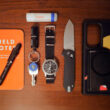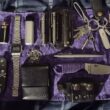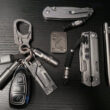Your EDC knife is only as good as the steel in its blade. A knife made of good steel will be sharp, stay sharp, and resists chipping. On the other hand, low-carbon knives made of dubious edge-holding steel are unreliable and downright unsafe. They tend to dull quickly, chipping and breaking when you need them most. There are a lot of high-quality blade steels to pick from, and each has its own set of advantages to consider for your EDC. This guide will cover what to look out for in knife steel before buying your next blade. To make things even easier for beginners, we’ll give a few examples of our favorite knives made of each type of steel.
Our Top Picks
The Best Overall Blade Steel: M390: Benchmade Bugout [Buy]
The Best Blade Steel on a Budget: 8Cr13MoV: Spyderco Persistence Lightweight [Buy]
The Best Blade Steel for the Outdoors: CPM-3V: Bark River Ultra Lite Bushcrafter Knife [Buy]
The Best Blade Steel for Food Prep: LC200N: Spyderco SpydieChef [Buy]
The Most Premium Blade Steel: CPM MagnaCut: Tactile Rockwall Thumbstud [Buy]
M390 Steel: Benchmade Bugout | 8Cr13MoV: Spyderco Persistence Lightweight | CPM-3V Steel: Bark River Ultra Lite Bushcrafter | LC200N Steel: Spyderco SpydieChef | CPM MagnaCut Steel: Tactile Rockwall Thumbstud |
 |  |  |  |  |
| $$$$ | $ | $$$$ | $$$$ | $$$$ |
| Blade Length: 3.24″ | Blade Length:: 2.77″ | Blade Length:: 3.25″ | Blade Length:: 3.32″ | Blade Length:: 2.84″ |
| Lock Type: AXIS lock | Lock Type: Liner | Lock Type: N/A | Lock Type: Frame | Lock Type: Insert lock |
| Key Features: Cerakoted blade | Key Features: 4-way pocket clip | Key Features: Contoured handles | Key Features: Rust-proof steel | Key Features: Ceramic detent and ball pivot bearings |
| Buy Now | Buy Now | Buy Now | Buy Now |
The Top Steel Knives in the Industry

AUS-8 Steel: CRKT CEO Flipper
PurchaseThe CRKT CEO Flipper is one of the most popular everyday carry knives. It’s a slim, sleek modern gent’s folding knife with a 3.11” AUS-8 stainless blade. Weighing just 1.9 ounces, the CEO Flipper makes for a comfortable and discreet EDC blade that’s easy to carry. This knife is a standout choice because of its classy design that will suit you well, even in a professional setting.

440C Steel: Boker Plus Credit Card Knife
PurchaseThe Boker Plus Credit Card knife is a compact everyday carry blade that folds down to the footprint of a standard payment card. This unique knife features a stout 440C stainless steel blade and a titanium frame to keep things lightweight at just 1.13 ounces. The Boker Plus Credit Card Knife is an excellent knife to have as a backup in case you forget a primary blade.

8Cr13MoV Steel: Spyderco Persistence Lightweight
PurchaseThe Spyderco Persistence Lightweight features a 2.75″ 8Cr13MoV stainless steel blade fashioned into their hallmark leaf shape. The knife is lighter than its original edition, partly due to a change in steel composition. The FRN scales also help keep the package lightweight at just 3.3 ounces. This knife is worth a look because of its affordable price and strong ergonomics.

VG-10 Steel: The James Brand Carter
PurchaseWith its fully ambidextrous design, The Carter accommodates users of any orientation, starting with its thumb disc deployment that gives you one-handed purchase from either side. This puts the knife’s 2.75“ VG-10 blade into play, in the classic drop point shape that gives it a sweeping belly for versatile cuts.

D2 Steel: SOG Flash AT
PurchaseThe Flash AT is one of SOG’s revitalized line of everyday carry folding knives. This knife’s unique features include an assisted opening mechanism that speeds deployment and the built-in blade safety provided by the XR lock. The D2 steel in the 3.5″ blade has been cryogenically heat-treated to get the maximum potential out of the material.

154CM Steel: Boker Burnley Kwaiken
PurchaseThe Boker Burnley Kwaiken takes its inspiration from traditional Japanese short swords. But unlike those antique weapons of war, this modern knife folds up for EDC. It also opens up quickly thanks to its push-button automatic opening system. This knife is unique because it’s an out-the-front knife, meaning the blade extends outwards once actuated. Being an OTF means you keep a firm grip on the aluminum handle since you don’t have to keep your hands clear of the edge as it opens. And its slim and sleek 3.5” blade has a slightly upswept profile, making it excel at detailed close-up cutting and slicing tasks.

CPM-3V Steel: Bark River Ultra Lite Bushcrafter Knife
PurchaseThe Bark River Ultra Lite Bushcrafter is a fixed-blade knife for outdoor camping and survival. Being a fixed blade, it does not fold, and it might not be the best option for most people’s EDC due to the size. This handmade knife might be bulkier than most folding knives, but at 2.8 ounces, it’s lighter than some folders. And thanks to its 3.35” CPM-3V steel blade and its ergonomically-shaped handle, it can easily feather wood and handle other hunting and outdoor tasks.

CPM-S35VN Steel: CRK Sebenza 31
PurchaseNo other knife exemplifies the use of CPM-S35VN stainless steel than the knife than the CRK Sebenza 31. S35VN owes its existence to this knife, as it was purpose-built for its use. The blade has been upgraded to S45VN to keep up with the times, but it’s still the grail knife for many in the everyday carry community. Another standout feature of this knife is the Reeve Integral Lock, which originated the frame lock concept. Its sturdiness owes itself to its 6Al4V titanium handle, and its minimalist looks add extra cache to carrying this knife.

LC200N Steel: Spyderco SpydieChef
PurchaseTrue to its name, the Spyderco Spydiechef takes its design cues from a chef’s knife. But unlike the knife you have in your block at home, this EDC knife folds. And thanks to its use of LC200N steel, it can stand up to cutting through acidic foods and other conditions that’ll make other blades rust without good maintenance. Its open-backed handle also makes it easier to clean after use with food. And thanks to its Reeve Integral frame lock, it stands up to constant use without folding on the user during the chop and slice.

CPM MagnaCut Steel: Tactile Rockwall Thumbstud
PurchaseKnown for their high-end bolt-action metal pens designed and crafted in the United States, Tactile has begun making quality everyday carry blades. One of their initial offerings features this super-premium CPM MagnaCut stainless steel. The Rockwall Thumbstud is a beautiful modern gents folding knife with that high-end steel and an all-titanium handle. The 2.84” blade features a flat grind, and it’s held together after a manual thumbstud opening with the insert lock in the handle.

M390 Steel: Benchmade Bugout
PurchaseThe Benchmade Bugout is one of the most popular everyday carry knives on this list, and the M390 stainless steel blade at its heart is one of the biggest reasons why it is so. This super-premium stainless steel features an extra Cerakote finish on the Bugout that makes it even more resistant to wear and rust over time. And its discreet deep carry style makes it a good option for multiple EDC uses, which explains its popularity.

CPM-CruWear Steel: Benchmade Mini Adamas
PurchaseThe Mini Adamas is Benchmade’s newest iteration of this tactical knife. As its name implies, it’s a smaller version of the folding knife, with an upgrade to the blade steel with the introduction of CPM-CruWear. With that steel, the Mini Adamas is a premium hard-use folding knife that’s easy to maintain and fix. It comes in two colors with the gray able to mix in with most loadouts, with grippy G-10 handle scales for a tactical EDC.

CPM-S90V Steel: Fox Knives Vox Yaru
PurchaseThe Fox Knives Vox Yaru features all the ergonomic hallmarks of a Jesper Voxnaes collaboration design. The standout feature is its reverse tanto blade with a pronounced belly that excels at slicing and chopping tasks. It’s also made out of CPM-S90V, making it hold that edge for a ridiculous amount of time. The strength of that super-premium blade steel also comes together with its well-defined point because it can pierce through rough material that would bend or chip other blades.
What to Look for in a Good Everyday Carry Blade Steel
- Hardness and durability: You want a durable knife that won’t bend because its steel is too soft. But the tradeoff is that you don’t want steel so hard that it becomes brittle and chips over time. A good mixture of these two qualities is best. Hardness is measured in terms of Rockwell (HRC) units, with higher values being generally better than lower values. Some of the most high-quality knife steel options use powder metallurgy and superior edge geometry to get the best performance out of a good edge.
The hardness of a knife’s steel dictates the maximum sharpness of the blade. While you can sharpen knives with harder steels to a more refined edge, it does come at a cost. It takes more effort and sometimes specialized equipment to sharpen blades with the most challenging steels. - Toughness: Toughness relates to a blade’s ability to stand up to hard use (and even abuse). Beyond standing up to everyday nicks and scratches, accidents and emergencies happen.
- Sharpness and edge retention: You want a knife that can get sharp and stay sharp through repeated use. A blade that is easy to sharpen and maintain is also good. Better edge retention means your new knife can cut sharp even during extended use. How hard a blade steel is also affects how sharp it can get. That’s determined by the amount of carbon in the steel. Other elements can also affect how well a blade can hold that edge through repeated rugged use.
- Corrosion resistance: This determines whether your knife is stainless or not. Non-stainless steel knives need oil and maintenance to keep the rust away. Stainless steel knives are forgiving, but they can still rust if neglected. The number of elements such as chromium content and vanadium in the steel alloy helps this out. Additionally, knives with a low carbon count have a high level of corrosion resistance, but the tradeoff is less prone to deformation and blunting.
- Ease of sharpening: All knives eventually get dull, and the only way to get them back into shape is to sharpen them. But you will notice that some blades take less effort to take on a keen edge than others. The first reason is hardness, as it can take more work and specialized tools to hone the edge of premium steel. But blade shape also plays a role. For example, sharpening a blade with a recurve edge takes some practice. Serrations can also pose added difficulty.
Knife manufacturers have a comprehensive set of names for each blade steel. The specific cutlery steel alloy used in making a knife is usually disclosed, letting you judge the quality. Generally, beware of dubious knives that do not advertise their blade steel. Unknown low-carbon steel should raise a red flag in your mind when you’re trying to buy a knife.
Main Types of Steel
Carbon Steel
Carbon is the primary element in a steel’s composition because it determines the maximum hardness of the blade. Pure carbon steels emphasize having lots of carbon above all else. The result is a high-performance blade with a good edge that can get very sharp. However, these carbon steels are incredibly susceptible to rusting when left wet, especially in saltwater areas. They can also stain and tarnish when they cut through acidic fruits and veggies.
Tool Steel
Tool steels are special alloys used originally to manufacture commercial and industrial tool bits and components. When used to make blades, tool steel knives have some of the best wear resistance on the market. While they are not as single-minded as pure carbon steel blades, they are not as rust-resistant as stainless steel. But with a good heat treat that exhibits excellent edge-holding properties. And their relative affordability compared to some of the super steels on this list make them a good starting point for EDC beginners.
Stainless Steel
Stainless steel blades are the most popular knives on the market. There are many kinds of high-quality stainless steel, each with unique properties. They range from softer budget cutlery steels to high-end premium powdered steels. Be wary of a knife that bills itself only as “stainless steel” without specifying the exact type. That’s a red flag for a cheaply-made and unsuitable pocket knife.
Steel for Knives FAQ
What is the best steel for making knife blades?
The best steel has a high-carbon content for hardness and sharpness. It should also be rust-resistant unless you do not care for that feature.
What is the strongest steel for a knife?
The strongest steel for a knife is CPM CruWear. Crucible’s S90V is also a contender for the strongest blade steel knives.
What is the best metal for a sharp knife?
Steel is the best metal for a sharp knife. Iron rusts too easily. Other metals do not provide the same amount of usefulness that steel brings to the table.
What is the difference between stainless steel and carbon steel?
Carbon steel rusts. Stainless steel resists rust. Some stainless steels resist rust more than others.
How we picked
Decades of experience and deep connections in the everyday carry industry give us a unique viewpoint on the market to inform our product recommendations. We have the depth of information for thousands of products that have come before and an extensive eye on the market to see what’s new and trending for each piece of gear. The result is a buying guide that we feel is informative and useful for EDCers of every trade, industry, and budget.
What is Everyday Carry?
Everyday Carry is both the concept of what people carry in their pockets and the process of picking out gear that thoughtfully considers what one wants or needs in their daily lives. It encompasses everything from style to preparedness to utility, meaning an entire industry full of valuable tools and essentials to choose from.
Why you should trust us
Our team has decades of combined experience in all aspects of everyday men’s essentials, from wallets to pens to bags and everything in between, and we know where to find great gear ideas that you may not come across at your local stores or when shopping online. Our expertise with the industry and familiarity in design, materials, and usability help you make more informed choices when it comes to picking up your next piece of gear.









